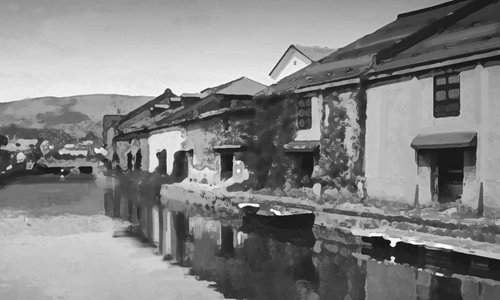Reconstructed Japanese town invokes nostalgia

Illustration: Liu Rui/GT
Wandering in the town of Otaru on the Japanese island of Hokkaido, one is overtaken by a nostalgic charm - being transported back in time to one of those black and white photos. The street views are mesmerizing, one of the reasons why the small town draws 6 million tourists annually.If you walk out of the old streets, step up along the inclined rampway and enter local communities, you will see the nostalgia in Otaru goes beyond the few old streets along the coast that is more touristy.
The town has retained its original flavor. Many old houses, in spite of having outdated designs, have been renovated, with nameplates at the doorstep showing the history of the architecture.
Otaru is an example of the reconstruction of Japan's old towns after World War II. The dispute around the Otaru Canal over 40 years ago has attracted nationwide attention.
The canal, built through 1914 to 1923, was a symbol of the town's past prosperity. Due to efforts by local residents and organizations, the canal and the architecture along it were well preserved.
Tourists from all over the world can see the "revival" of the town which used to be the economic center of Hokkaido. In the eyes of Japanese people, especially local residents, what matters more is the continuation of traditional communities. This is not only about the reconstruction of buildings, but also preservation of indigenous lifestyles.
Between the 1970s and 1990s, more than 3 million people in Otaru participated in activities such as building the canal and renovating the old own. Many plans were proposed by the residents themselves. These people say, the real hometown is where your heart is.
A friend living in Japan for years told me that the country carried out large-scale renovation or upgrading of medium- and small-sized towns after WWII, but it did not scrap them and start all over again. Instead, the government has reconditioned the houses and kept the original community traditions.
Nowadays, some small stores in Japanese towns may look shabby, but feature completely new facilities inside. The way these stores communicate with local residents has been kept alive.
Much of the renovation does not aim to deliberately attract more tourists, but it indeed brings in footfalls. The traditional lifestyle of communities has remained and these stores serve as foundations of social mobility.
The postwar community renovation in Japan mostly relied on civil groups and ordinary residents, especially housewives and those born during the first baby boom from 1947 to 1949. Their mission was passed on to the younger generation.
The Japanese government also set up special departments in charge of outlining plans for postwar community renovation and provided financial support. Many local enterprises contributed.
The decision-making and coordination capability of community organizations was enhanced in the process, and the employees became the backbone of middle classes in postwar Japan.
The maintenance of traditional communities by this generation and their commitment to community development as key players is an important reason for social stability in the country after WWII. Meanwhile, Japanese society tended to become conservative. Stability and conservatism are two sides of a coin. The future trajectory of social thought in Japan, to some extent, relates to the loyalty of the younger generation toward traditional communities.
The author is a senior editor with the People's Daily and currently a senior fellow with the Chongyang Institute for Financial Studies at Renmin University of China. dinggang@globaltimes.com.cn. Follow him on Twitter @dinggangchina

